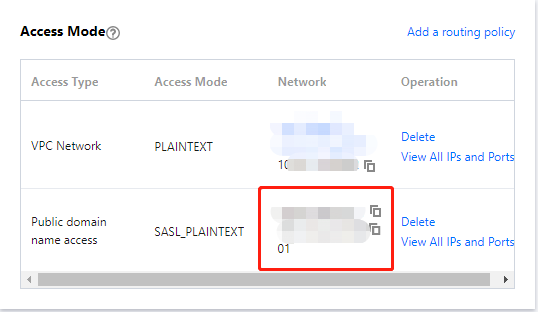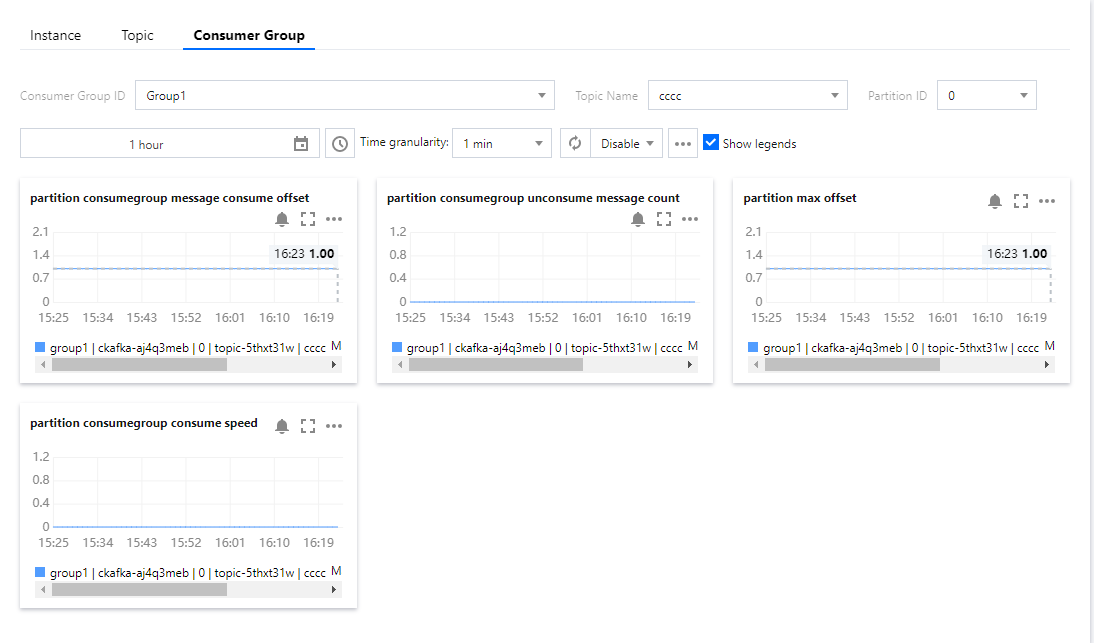- Release Notes and Announcements
- Product Introduction
- Purchase Guide
- Getting Started
- Operation Guide
- Instance Management
- Creating Instance
- Naming with Consecutive Numeric Suffixes or Designated Pattern String
- Viewing Instance
- Upgrading Instance
- Downgrading Instance Configuration
- Terminating/Returning Instances
- Change from Pay-as-You-Go to Monthly Subscription
- Upgrading Instance Version
- Adding Routing Policy
- Public Network Bandwidth Management
- Connecting to Prometheus
- AZ Migration
- Setting Maintenance Time
- Setting Message Size
- Topic Management
- Consumer Group
- Monitoring and Alarms
- Smart Ops
- Permission Management
- Tag Management
- Querying Message
- Event Center
- Migration to Cloud
- Data Compression
- Instance Management
- CKafka Connector
- Best Practices
- Best Practices of CKafka Client
- Connector Best Practices
- Connecting Flink to CKafka
- Connecting Schema Registry to CKafka
- Connecting Spark Streaming to CKafka
- Connecting Flume to CKafka
- Connecting Kafka Connect to CKafka
- Connecting Storm to CKafka
- Connecting Logstash to CKafka
- Connecting Filebeat to CKafka
- Multi-AZ Deployment
- Production and Consumption
- Log Access
- Replacing Supportive Route (Old)
- Troubleshooting
- API Documentation
- History
- Introduction
- API Category
- Making API Requests
- DataHub APIs
- ACL APIs
- Topic APIs
- BatchModifyGroupOffsets
- BatchModifyTopicAttributes
- CreateConsumer
- CreateDatahubTopic
- CreatePartition
- CreateTopic
- CreateTopicIpWhiteList
- DeleteTopic
- DeleteTopicIpWhiteList
- DescribeDatahubTopic
- DescribeTopic
- DescribeTopicAttributes
- DescribeTopicDetail
- DescribeTopicProduceConnection
- DescribeTopicSubscribeGroup
- FetchMessageByOffset
- FetchMessageListByOffset
- ModifyDatahubTopic
- ModifyTopicAttributes
- DescribeTopicSyncReplica
- Instance APIs
- Route APIs
- Other APIs
- Data Types
- Error Codes
- SDK Documentation
- General References
- FAQs
- Service Level Agreement (New Version)
- Contact Us
- Glossary
- Release Notes and Announcements
- Product Introduction
- Purchase Guide
- Getting Started
- Operation Guide
- Instance Management
- Creating Instance
- Naming with Consecutive Numeric Suffixes or Designated Pattern String
- Viewing Instance
- Upgrading Instance
- Downgrading Instance Configuration
- Terminating/Returning Instances
- Change from Pay-as-You-Go to Monthly Subscription
- Upgrading Instance Version
- Adding Routing Policy
- Public Network Bandwidth Management
- Connecting to Prometheus
- AZ Migration
- Setting Maintenance Time
- Setting Message Size
- Topic Management
- Consumer Group
- Monitoring and Alarms
- Smart Ops
- Permission Management
- Tag Management
- Querying Message
- Event Center
- Migration to Cloud
- Data Compression
- Instance Management
- CKafka Connector
- Best Practices
- Best Practices of CKafka Client
- Connector Best Practices
- Connecting Flink to CKafka
- Connecting Schema Registry to CKafka
- Connecting Spark Streaming to CKafka
- Connecting Flume to CKafka
- Connecting Kafka Connect to CKafka
- Connecting Storm to CKafka
- Connecting Logstash to CKafka
- Connecting Filebeat to CKafka
- Multi-AZ Deployment
- Production and Consumption
- Log Access
- Replacing Supportive Route (Old)
- Troubleshooting
- API Documentation
- History
- Introduction
- API Category
- Making API Requests
- DataHub APIs
- ACL APIs
- Topic APIs
- BatchModifyGroupOffsets
- BatchModifyTopicAttributes
- CreateConsumer
- CreateDatahubTopic
- CreatePartition
- CreateTopic
- CreateTopicIpWhiteList
- DeleteTopic
- DeleteTopicIpWhiteList
- DescribeDatahubTopic
- DescribeTopic
- DescribeTopicAttributes
- DescribeTopicDetail
- DescribeTopicProduceConnection
- DescribeTopicSubscribeGroup
- FetchMessageByOffset
- FetchMessageListByOffset
- ModifyDatahubTopic
- ModifyTopicAttributes
- DescribeTopicSyncReplica
- Instance APIs
- Route APIs
- Other APIs
- Data Types
- Error Codes
- SDK Documentation
- General References
- FAQs
- Service Level Agreement (New Version)
- Contact Us
- Glossary
Using SDK to Receive/Send Message (Recommended)
Last updated: 2024-01-09 14:45:02
Overview
This document describes how to access CKafka to receive/send messages with the SDK for Java on the public network. For clients in other languages, see SDK Documentation.
Prerequisites
You have installed JDK 1.8 or later.
You have installed Maven 2.5 or later.
You have downloaded the demo.
Directions
Step 1. Prepare configurations
1. Decompress the downloaded demo and enter the
PUBLIC_SASL directory under javakafkademo.2. Modify a JAAS configuration file named
ckafka_client_jaas.conf.KafkaClient {org.apache.kafka.common.security.plain.PlainLoginModule requiredusername="yourinstance#yourusername"password="yourpassword";};
Note:
Set
username to a value in the format of instance ID + # + configured username, and password to a configured password.3. Modify a Kafka configuration file named
kafka.properties.## Configure the accessed network by copying the information in the **Network** column in the **Access Mode** section on the instance details page in the console.bootstrap.servers=ckafka-xxxxxxx## Configure the topic by copying the information on the **Topic Management** page in the consoletopic=XXX## Configure the consumer group as neededgroup.id=XXX## The path of the JAAS configuration file named `ckafka_client_jaas.conf`java.security.auth.login.config.plain=/xxxx/ckafka_client_jaas.conf
Parameter | Description |
bootstrap.servers | Accessed network, which can be copied in the Network column in the Access Mode section on the instance details page in the console.  |
topic | Topic name, which can be copied on the Topic Management page in the console.  |
group.id | You can customize it. After the demo runs successfully, you can see the consumer on the Consumer Group page. |
java.security.auth.login.config.plain | Enter the path of the JAAS configuration file ckafka_client_jaas.conf. |
Step 2. Send messages
1. Compile and run the message sending program
CKafkaSaslProducerDemo.java.public class CKafkaSaslProducerDemo {public static void main(String args[]) {// Set the path of the JAAS configuration file.CKafkaConfigurer.configureSaslPlain();// Load `kafka.properties`.Properties kafkaProperties = CKafkaConfigurer.getCKafkaProperties();Properties props = new Properties();// Set the access point. Obtain the access point of the corresponding topic in the console.props.put(ProducerConfig.BOOTSTRAP_SERVERS_CONFIG, kafkaProperties.getProperty("bootstrap.servers"));// Set the access protocol.props.put(CommonClientConfigs.SECURITY_PROTOCOL_CONFIG, "SASL_PLAINTEXT");// Set the PLAIN mechanism.props.put(SaslConfigs.SASL_MECHANISM, "PLAIN");// Set the method of serializing CKafka messages.props.put(ProducerConfig.KEY_SERIALIZER_CLASS_CONFIG, "org.apache.kafka.common.serialization.StringSerializer");props.put(ProducerConfig.VALUE_SERIALIZER_CLASS_CONFIG, "org.apache.kafka.common.serialization.StringSerializer");// Set the maximum request wait time.props.put(ProducerConfig.MAX_BLOCK_MS_CONFIG, 30 * 1000);// Set the number of retries for the client.props.put(ProducerConfig.RETRIES_CONFIG, 5);// Set the internal retry interval for the client.props.put(ProducerConfig.RECONNECT_BACKOFF_MS_CONFIG, 3000);// Construct a producer object. Note that a producer object is thread-safe, and generally one producer object is sufficient for a process.KafkaProducer<String, String> producer = new KafkaProducer<>(props);// Construct a CKafka message.String topic = kafkaProperties.getProperty("topic"); // Topic of the message. Enter the topic you created in the console.String value = "this is ckafka msg value"; // Message contenttry {// Obtaining the future objects in batches can accelerate the speed. Do not include too many objects in a batch.List<Future<RecordMetadata>> futures = new ArrayList<>(128);for (int i =0; i < 100; i++) {// Send the message and obtain a future object.ProducerRecord<String, String> kafkaMessage = new ProducerRecord<>(topic, value + ": " + i);Future<RecordMetadata> metadataFuture = producer.send(kafkaMessage);futures.add(metadataFuture);}producer.flush();for (Future<RecordMetadata> future: futures) {// Sync the future object obtained.RecordMetadata recordMetadata = future.get();System.out.println("Produce ok:" + recordMetadata.toString());}} catch (Exception e){// If the sending still fails after the internal retries in the client, the system needs to report and handle the error.System.out.println("error occurred");}}}
2. View the execution result (output).
Produce ok:ckafka-topic-demo-0@198Produce ok:ckafka-topic-demo-0@199
3. On the Topic Management tab page on the instance details page in the CKafka console, select the target topic and click More > Message Query to view the message just sent.

Step 3. Consume messages
1. Compile and run the message subscription program
CKafkaSaslConsumerDemo.java.public class CKafkaSaslConsumerDemo {public static void main(String args[]) {// Set the path of the JAAS configuration file.CKafkaConfigurer.configureSaslPlain();// Load `kafka.properties`.Properties kafkaProperties = CKafkaConfigurer.getCKafkaProperties();Properties props = new Properties();// Set the access point. Obtain the access point of the corresponding topic in the console.props.put(ProducerConfig.BOOTSTRAP_SERVERS_CONFIG, kafkaProperties.getProperty("bootstrap.servers"));// Set the access protocol.props.put(CommonClientConfigs.SECURITY_PROTOCOL_CONFIG, "SASL_PLAINTEXT");// Set the PLAIN mechanism.props.put(SaslConfigs.SASL_MECHANISM, "PLAIN");// Set the maximum interval between two polls.// If the consumer does not return a heartbeat message within the interval, the broker will determine that the consumer is not alive, and then remove the consumer from the consumer group and trigger rebalancing. The default value is 30s.props.put(ConsumerConfig.SESSION_TIMEOUT_MS_CONFIG, 30000);// Set the maximum number of messages that can be polled at a time.// Do not set this parameter to an excessively large value. If polled messages are not all consumed before the next poll starts, load balancing is triggered and lagging occurs.props.put(ConsumerConfig.MAX_POLL_RECORDS_CONFIG, 30);// Set the method of deserializing messages.props.put(ConsumerConfig.KEY_DESERIALIZER_CLASS_CONFIG, "org.apache.kafka.common.serialization.StringDeserializer");props.put(ConsumerConfig.VALUE_DESERIALIZER_CLASS_CONFIG, "org.apache.kafka.common.serialization.StringDeserializer");// Set the consumer group of the current consumer instance after you apply for one in the console.// The instances in the same consumer group consume messages in load balancing mode.props.put(ConsumerConfig.GROUP_ID_CONFIG, kafkaProperties.getProperty("group.id"));// Construct a consumer object. This generates a consumer instance.KafkaConsumer<String, String> consumer = new KafkaConsumer<String, String>(props);// Set one or more topics to which the consumer group subscribes.// We recommend that you configure consumer instances with the same `GROUP_ID_CONFIG` value to subscribe to the same topics.List<String> subscribedTopics = new ArrayList<String>();// If you want to subscribe to multiple topics, add the topics here.// You must create the topics in the console in advance.String topicStr = kafkaProperties.getProperty("topic");String[] topics = topicStr.split(",");for (String topic: topics) {subscribedTopics.add(topic.trim());}consumer.subscribe(subscribedTopics);// Consume messages in loopwhile (true){try {ConsumerRecords<String, String> records = consumer.poll(1000);// All messages must be consumed before the next poll, and the total duration cannot exceed the timeout interval specified by `SESSION_TIMEOUT_MS_CONFIG`.for (ConsumerRecord<String, String> record : records) {System.out.println(String.format("Consume partition:%d offset:%d", record.partition(), record.offset()));}} catch (Exception e){System.out.println("consumer error!");}}}}
2. View the execution result.
Consume partition:0 offset:298Consume partition:0 offset:299
3. On the Consumer Group page in the Ckafka console, click the triangle icon on the left of the target consumer group name, enter the topic name in the search box, and click View Details to view the consumption details.


 Yes
Yes
 No
No
Was this page helpful?